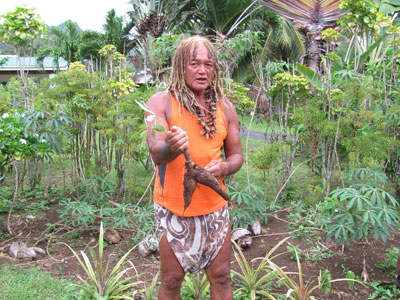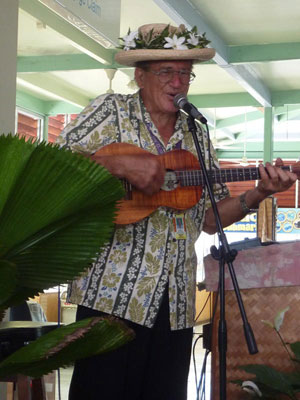Volunteering in the Cook Islands
by Nancy Logan; Jamestown, RI
My husband, Joe, and I went to Xi’an, China, with Global Volunteers in 2002 for one of our most unforgettable vacations. For two weeks we stayed in a hotel with 16 other volunteers and each weekday we went to a large school to help with their English program.
In October 2010 we again traveled with Global Volunteers to a special place, this time visiting Rarotonga, in the Cook Islands, with 14 other volunteers ranging in age from their 20s to their 70s.
Global Volunteers has been organizing these one- to three-week service programs for 26 years and is active in the Americas, Europe, Africa, the Pacific Islands and Asia. They work very closely with local host organizations to respond to the specific needs of their communities.
Programs vary, with opportunities to work in education, health care, rehab centers, libraries and conservation regions, among other options. In each location, a country manager meets with the volunteers daily. In Rarotonga, our country managers were Debbie Futter Puati and her husband, James.
Settling in
On the afternoon of Oct. 22, after flying for 24 hours and sitting in airports for eight hours, we arrived in Rarotonga. When we got to the van that would take us to our “home” for the next two weeks, we were greeted with fresh flower leis and smiles.
Our group stayed at the KiiKii Motel, about a 40-minute walk (or five- to ten-minute bus ride) from the center of the town. It was in a lovely setting on the waterfront, and our large room included a kitchenette, a comfortable bed, a table, chairs, a TV (one channel), a porch with chairs and a fan. Towels were provided, but soap, shampoo, washcloths, laundry soap and decaf coffee were not. There was a large pool on the grounds where I often swam laps.
Our group used a special building, which was open all the time for us, for meals, meetings and language lessons. Breakfast was available daily and most dinners were catered there. Several times a week we went out for dinner and entertainment with our group leaders. We prepared our own lunches to take with us to “work.”
We were given bus passes to get us to our work locations each day. Buses left from the center of town every half hour, going clockwise around the island on the hour and “anticlockwise” on the half hour. Every time I took the bus, I was impressed by everyone’s politeness. All passengers, young and old, thanked the bus driver as they left the bus!
One unique activity that volunteers can participate in is taking turns writing in a journal, which is read at each breakfast meeting. Listening to the journal entries, we were moved by the dedication and innovations of our companions. Most went way beyond their “job description” — leading singing games, rehearsing a play, building a wind vane and even filling in for an absent principal.
Joe spent half his time at the St. Joseph’s School — a small Catholic school for grades one to six, with about 30 students in each grade — helping students with reading problems by having them read to him. They were very friendly and interesting to work with.
He also spent four days working in the conservation area, clearing trails that had been overgrown and blocked by fallen trees (from a cyclone); helping bait rat traps, used to reduce the population of rats, which are harmful to endemic species of birds, and building steps on a steep trail. It was hard manual labor but rewarding. The conservation area managers told the volunteers much about the local trees and ecology.
I spent one day in the Historical Society’s library/museum photocopying books — a boring job but needed. The museum was very interesting.
For the remainder of my time, I volunteered at the Rutaki Elementary School, a very small school for kids from kindergarten to sixth grade (about 10 to 15 students in each grade). I worked with the fourth- to sixth-graders.
They were wonderful to be with, always happy and exuberant, but frustratingly poor in reading.
For one of our volunteers, this was his fifth year in a row in Rarotonga, and for another it was her second.
Free time
Many of us took advantage of various activities and tours on the island on weekends and holidays. These tours cost extra. We took three island tours during our free time.
Six of us took the “Nature Trail Tour,” which was memorable. It was led by Pa Teuraa, a local herbalist, botanist and traditional healer.
We were picked up at our motel at 9 a.m. and taken to his home, where our walking tour began — a delightful couple of hours, with Pa identifying many plants. We walked through a plantation to the mountain, where we climbed for about an hour.
Ending back at his unique home, we had a delicious lunch, returning to our motel at about 2:00. The cost, NZD40 ($30), was well worth it.
We also took the “Raro Mountain Safari Tour” in four-wheel-drive vehicles up and down several mountains, with a delicious cookout at the end. The tour (NZD60) lasted about four hours and offered some terrific views from the top of the mountains.
The final tour we enjoyed was from Captain Tama’s Lagoon Cruizes. We went out in a glass-bottom boat from 11 a.m. to 3:30 p.m. and had the chance to go snorkeling off the boat for one-half to one hour. We had our own snorkeling gear, but gear was available for anyone who needed it. I was most excited to see bright-blue starfish.
We landed on Muri Island for swimming, walking around and a delicious barbecue, followed by music and demonstrations of how to cut a coconut and six ways to tie a pareo (sarong). This tour cost NZD70, and we felt it was worth it.
We also visited the Saturday morning outdoor market, with about 50 stands selling crafts and local produce from the countryside. I purchased several items from the craftsmen who made them.
Sunday services at one of the Cook Islands’ Christian churches — with fascinating singing and parishioners dressed in their Sunday best — is not to be missed.
Everyone we encountered spoke English, though I discovered that children speak Maori, their native language, in school through the third grade. From the fourth grade on, they are required to speak and read English. All books in the school library were in English, and numerous students had reading problems.
The details
The cost for our two weeks on Rarotonga, including double accommodations, all meals with the group, transportation to our “jobs” and special excursions organized by the country manager, was $2,595 per person. A three-week stay cost about $2,795 per person. Discounts are available for returning volunteers.
We made our own flight arrangements. There is a direct flight once a week from Los Angeles. We went from Boston to Los Angeles to Auckland and on to Rarotonga.
Those who came one or more days early paid extra for their own rooms, meals and island transportation during that period.
Global Volunteers (St. Paul, MN; 800/487-1074) has an excellent manual with plenty of background information about the communities in which volunteers will be working. In 2011 there are seven groups scheduled for Rarotonga.
Upon leaving the airport (at 1:30 a.m.!), we were entertained by a man with his guitar singing, “I’m leaving on a jet plane. Don’t know when I’ll be back again… .”
We’ll always remember this experience.




